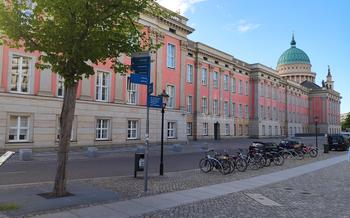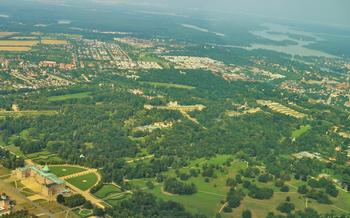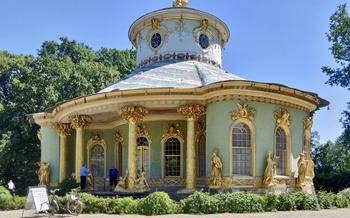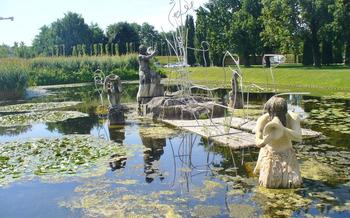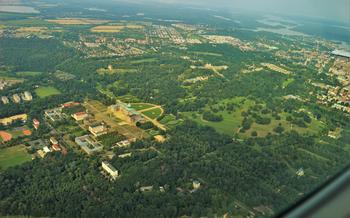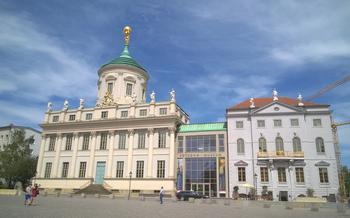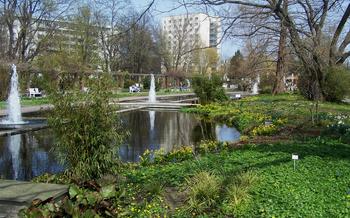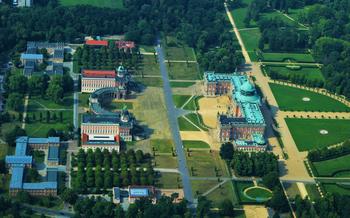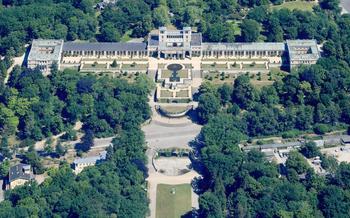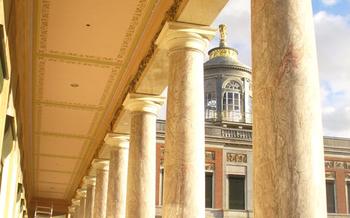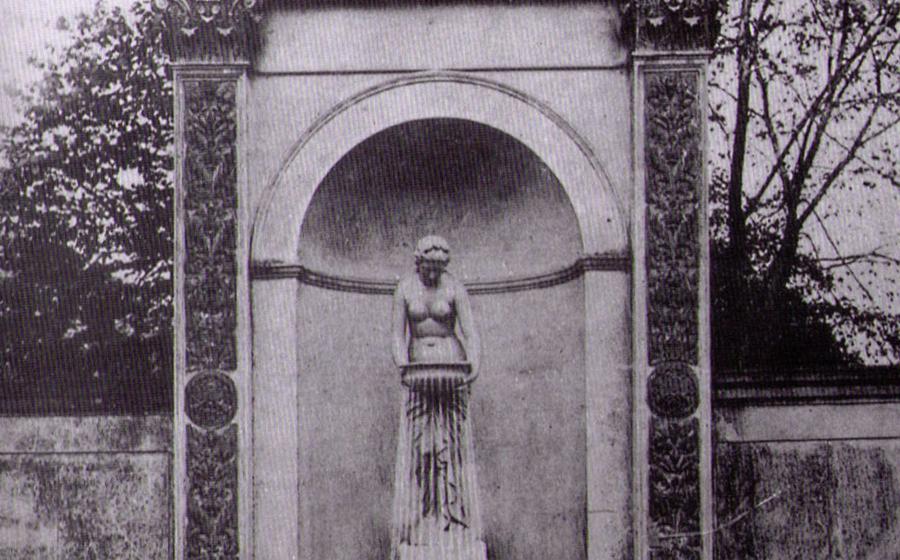
Sanssouci Park with its palaces
- Sanssouci Palace: The Jewel of the Park
- New Palace: A Statement of Grandeur
- Orangery Palace: A Tropical Oasis
- Picture Gallery: A Treasure Trove of Art
- Neptune Grotto: A Watery Wonder
- Marble Palace: A Classical Gem
- Roman Baths: A Relaxing Retreat
- Orangery Terrace: A Panoramic Vista
- Rose Garden: A Fragrant Oasis
- Insider Tip: Explore the Park by Bike
Sanssouci Palace: The Jewel of the Park
Sanssouci Palace, the epitome of Prussian elegance, stands as the crowning jewel of Sanssouci Park. Built between 1745 and 1747 under the watchful eye of King Frederick the Great, this majestic palace embodies the essence of Rococo architecture, characterized by its intricate ornamentation, graceful curves, and harmonious proportions.
The palace's exterior facade boasts a captivating blend of sandstone and stucco, adorned with delicate carvings, intricate moldings, and sculpted figures. Its single-story design, a departure from the traditional multi-storied palaces of the time, reflects Frederick's desire for intimacy and a close connection to nature.
Step inside the palace, and you'll be greeted by a symphony of opulence and sophistication. The Grand Gallery, the palace's centerpiece, captivates with its gleaming marble floors, vaulted ceilings adorned with intricate stuccowork, and floor-to-ceiling windows that flood the room with natural light. The gallery's walls are adorned with a treasure trove of artworks, including paintings, sculptures, and tapestries, showcasing the refined taste and discerning eye of Frederick the Great.
The palace's interior is a testament to Frederick's passion for the arts and his desire to create a private refuge where he could indulge in his intellectual and artistic pursuits. Each room is meticulously decorated, reflecting the king's personal style and preferences. From the elegant bedrooms to the intimate study, every corner of the palace exudes a sense of grandeur and refinement.
Sanssouci Palace stands not only as an architectural masterpiece but also as a symbol of Frederick the Great's legacy. It served as his summer palace and a place where he could escape the rigors of court life, entertain guests, and pursue his intellectual interests. The palace played a pivotal role in Prussian history, hosting countless diplomatic meetings, cultural gatherings, and musical performances.
New Palace: A Statement of Grandeur
The New Palace (Neues Palais), situated in the heart of Sanssouci Park, stands as a testament to Prussian opulence and architectural prowess. Built between 1763 and 1769 at the behest of Frederick the Great, the palace served as a grand residence for royal guests and a venue for lavish state events.
In stark contrast to the intimate charm of Sanssouci Palace, the New Palace exudes an aura of grandeur with its colossal size and elaborate Baroque-Rococo architectural style. Its imposing facade, adorned with intricate carvings and statues, hints at the splendor that awaits within.
The palace's opulent interiors are a feast for the senses, boasting a breathtaking array of opulent furnishings, exquisite artwork, and gleaming crystal chandeliers. The Grand Gallery, the centerpiece of the palace, stretches for an impressive 145 meters and is adorned with towering Corinthian columns, ornate ceiling frescoes, and a dazzling collection of paintings.
The New Palace stands as a symbol of Prussia's rise to prominence during the 18th century. Its grandeur reflects the power and ambition of Frederick the Great, who sought to create a palace that would rival those of his European counterparts. Today, the New Palace remains a testament to the extravagance and artistic achievements of the Prussian era.
Practical Information:
- Opening Hours: April to October: 10 am - 5 pm; November to March: 10 am - 4 pm
- Admission Fees: Adults: €12, Concessions: €6
- Guided Tours: Available in English and German
- Accessibility: The palace is wheelchair accessible via a ramp at the main entrance.
Orangery Palace: A Tropical Oasis
Amidst the lush greenery of Sanssouci Park, the Orangery Palace stands out as a unique and captivating sight. Originally conceived as a winter garden, this magnificent palace was built by King Frederick William IV in the mid-19th century. Its striking architectural design, inspired by Italian Renaissance villas, features a long, low-lying structure adorned with graceful arcades and a central dome.
Step inside the Orangery Palace, and you'll be greeted by a world of exotic flora and fauna. The palace's primary function was to house a vast collection of citrus trees and other tropical plants, which were carefully tended to during the winter months. Today, visitors can still admire the remnants of this botanical wonderland, with many rare and beautiful species on display.
The palace's interior is equally impressive, featuring a grand central hall that leads to a series of smaller rooms, each with its own unique character. The walls are adorned with intricate stucco work and colorful frescoes, while the floors are inlaid with marble and intricate mosaics.
Practical Information:
- The Orangery Palace is open to the public from April to October, with guided tours available in multiple languages.
- Admission fees apply, and advance booking is recommended, especially during peak season.
- The palace is wheelchair accessible, and guided tours for visitors with disabilities can be arranged upon request.
- The Orangery Palace is a popular venue for concerts, exhibitions, and other cultural events throughout the year. Check the official website for more information.
Picture Gallery: A Treasure Trove of Art
The Picture Gallery, situated in the heart of Sanssouci Park, stands as a testament to the artistic patronage of the Prussian kings. Erected in the mid-18th century, this elegant structure houses a remarkable collection of paintings that spans various eras and genres. The gallery's impressive holdings include masterpieces by renowned artists such as Rubens, Caravaggio, van Dyck, and Cranach the Elder.
Visitors to the Picture Gallery are greeted by a harmonious blend of Baroque and Rococo architectural elements. The gallery's interior boasts a spacious central hall adorned with intricate stucco work, gilded ornaments, and gleaming chandeliers. The walls are lined with a series of intimate cabinets, each dedicated to a specific artistic period or theme.
Among the highlights of the collection are Rubens' dynamic and colorful depiction of "The Abduction of the Daughters of Leucippus," Caravaggio's haunting and enigmatic "The Entombment of Christ," and van Dyck's refined and elegant portraits of the Stuart monarchs. The gallery also features a notable collection of Dutch and Flemish paintings, including works by Rembrandt, Hals, and Bruegel the Elder.
A visit to the Picture Gallery offers art enthusiasts an opportunity to immerse themselves in the rich artistic heritage of Europe. Whether you're drawn to the vibrant colors of the Baroque era or the meticulous detail of the Renaissance masters, the gallery's diverse collection is sure to captivate and inspire.
Neptune Grotto: A Watery Wonder
Nestled within the enchanting Sanssouci Park, the Neptune Grotto stands as a testament to the ingenuity and artistry of the 18th century. This captivating grotto, commissioned by Frederick the Great, draws inspiration from Roman mythology and serves as an oasis of tranquility amidst the vibrant park.
The grotto's design is a masterpiece of Baroque architecture, featuring an intricate arrangement of rocks, sculptures, and water features. Its centerpiece is a majestic statue of Neptune, the Roman god of the sea, commanding attention with its imposing presence. Water cascades down the grotto's walls, creating a soothing symphony that adds to the serene atmosphere.
Beyond its aesthetic appeal, the Neptune Grotto holds symbolic significance. The choice of Neptune as the central figure reflects Frederick the Great's desire to emulate the power and grandeur of ancient Rome. The grotto's watery theme symbolizes the king's ambition to expand Prussia's naval power and establish a strong maritime presence.
Visiting the Neptune Grotto is a must for anyone seeking a unique and immersive experience in Sanssouci Park. Its combination of natural beauty, historical significance, and artistic merit makes it a true hidden gem waiting to be discovered.
Marble Palace: A Classical Gem
Amidst the lush greenery of Sanssouci Park, the Marble Palace stands as a testament to the grandeur and opulence of the Prussian monarchy. Constructed between 1787 and 1792 under the reign of Frederick William II, this magnificent palace is a masterpiece of Neoclassical architecture, inspired by the ancient Roman villas of antiquity.
The palace's exterior exudes an air of elegance and symmetry, with its pristine white marble facade adorned with intricate carvings, delicate moldings, and graceful columns. The grand entrance, featuring a sweeping staircase and a portico supported by towering Ionic columns, invites visitors into a world of refined luxury.
Inside, the Marble Palace boasts a series of lavishly decorated state rooms, each showcasing a unique theme or style. The Grand Hall, with its soaring ceiling and shimmering chandeliers, serves as a fitting reception area for distinguished guests. The White Hall, adorned with exquisite white marble sculptures and bas-reliefs, exudes a sense of purity and serenity. The Green Hall, with its vibrant green marble walls and intricate parquet floor, creates an intimate and inviting atmosphere.
Throughout the palace, visitors can admire a treasure trove of artworks, including paintings, sculptures, and tapestries, carefully curated to reflect the refined taste and cultural interests of Frederick William II. The palace also houses a collection of antique furniture, porcelain, and other decorative objects, offering a glimpse into the opulent lifestyle of the Prussian court.
Roman Baths: A Relaxing Retreat
The Roman Baths, a testament to the architectural prowess of the Prussian era, are a must-visit attraction within the Sanssouci Park. Constructed during the reign of Frederick William II, these baths were inspired by the ancient Roman bathing culture. The intricate design and classical elements transport visitors back to the grandeur of the Roman Empire.
The Roman Baths feature a central rotunda surrounded by a series of smaller chambers, each serving a specific purpose. The Tepidarium, with its warm temperatures, was used for relaxation and socializing, while the Caldarium, with its steamy atmosphere, was ideal for therapeutic bathing. The Frigidarium, with its cool plunge pool, provided a refreshing contrast to the heat of the other chambers.
Beyond their practical function, the Roman Baths are adorned with exquisite artwork and sculptures. The walls are adorned with intricate mosaics depicting scenes from Roman mythology, while the niches house statues of Roman gods and goddesses. The attention to detail and the harmonious blend of architecture and art create a truly immersive experience.
Today, the Roman Baths serve as a tranquil oasis within the bustling park. Visitors can wander through the chambers, marvel at the preserved frescoes, and soak in the serene atmosphere. Guided tours are available, providing insights into the history, architecture, and cultural significance of this remarkable attraction.
Orangery Terrace: A Panoramic Vista
The Orangery Terrace, a stunning architectural feature within Sanssouci Park, offers breathtaking panoramic vistas that will leave you spellbound. Perched atop a hill, the terrace commands a majestic view of the park's sprawling expanse, showcasing its intricate gardens, manicured lawns, and shimmering fountains. The terrace's elevated position allows visitors to admire the park's grandeur from a unique perspective, capturing the essence of its meticulously planned design.
The terrace is adorned with elegant balustrades and adorned with ornate urns, adding a touch of sophistication to its surroundings. Its spacious layout provides ample space for visitors to relax and soak in the serene atmosphere, while enjoying the panoramic views. Whether you choose to bask in the warmth of the sun or seek shade beneath the shade of the trees, the Orangery Terrace offers an ideal setting for contemplation and tranquility.
To fully appreciate the Orangery Terrace's charm, consider visiting during the golden hour, when the setting sun casts a warm glow upon the park, creating a magical ambiance. As the sky transforms into a canvas of vibrant hues, the park takes on a new dimension, with its pathways and landmarks illuminated in a soft, ethereal light. This enchanting spectacle is sure to leave a lasting impression, making your visit to Sanssouci Park truly unforgettable.
Rose Garden: A Fragrant Oasis
Nestled within the sprawling Sanssouci Park, the Rose Garden is a sanctuary of beauty and fragrance that captivates the senses. Established in the 18th century, this enchanting garden showcases a diverse collection of roses from around the world, each vying for attention with its vibrant hues and intoxicating aromas.
Visitors are greeted by a riot of colors as they step into the garden, where over 2,500 rose bushes burst forth in a symphony of blooms. From the classic red and white varieties to the more exotic shades of yellow, purple, and orange, the roses create a breathtaking kaleidoscope that delights the eye.
The garden's layout is designed to enhance the visitor experience, with winding paths that meander through meticulously manicured beds. Each bed is dedicated to a specific type of rose, allowing visitors to learn about the different varieties and appreciate their unique characteristics.
In addition to its aesthetic appeal, the Rose Garden serves as an important center for rose research and education. The garden's team of experts is dedicated to preserving and cultivating rare and endangered rose species, ensuring their survival for future generations.
Throughout the year, the Rose Garden hosts a variety of educational programs and events that cater to both rose enthusiasts and casual visitors alike. Guided tours offer insights into the history, cultivation, and care of roses, while workshops and seminars provide hands-on experiences for those who want to learn more about these captivating flowers.
Whether you're a seasoned rose aficionado or simply seeking a tranquil retreat, the Rose Garden at Sanssouci Park is a must-visit destination. Immerse yourself in the beauty and fragrance of these timeless blooms, and let the worries of the world melt away as you wander through this enchanting oasis.
Insider Tip: Explore the Park by Bike
For an active and immersive experience, consider exploring Sanssouci Park by bike. With its wide, well-maintained paths and relatively flat terrain, the park is ideal for cycling enthusiasts of all levels. Bike rental shops in Potsdam offer various options, from city bikes to electric bikes, to suit your needs and preferences.
Choose from several suggested biking routes that cater to different interests and fitness levels. For a leisurely ride, opt for the 6-kilometer circuit around the park, which takes you past all the major attractions. If you're up for a challenge, embark on the 12-kilometer route that extends into the surrounding forest, offering a mix of urban and natural scenery.
Before setting off, ensure you have a map or download a cycling app to navigate the park's extensive network of paths. Remember to wear a helmet and follow the designated bike lanes for a safe and enjoyable cycling experience. Take advantage of the numerous bike racks located throughout the park to conveniently park your bike while exploring the palaces and gardens on foot.
